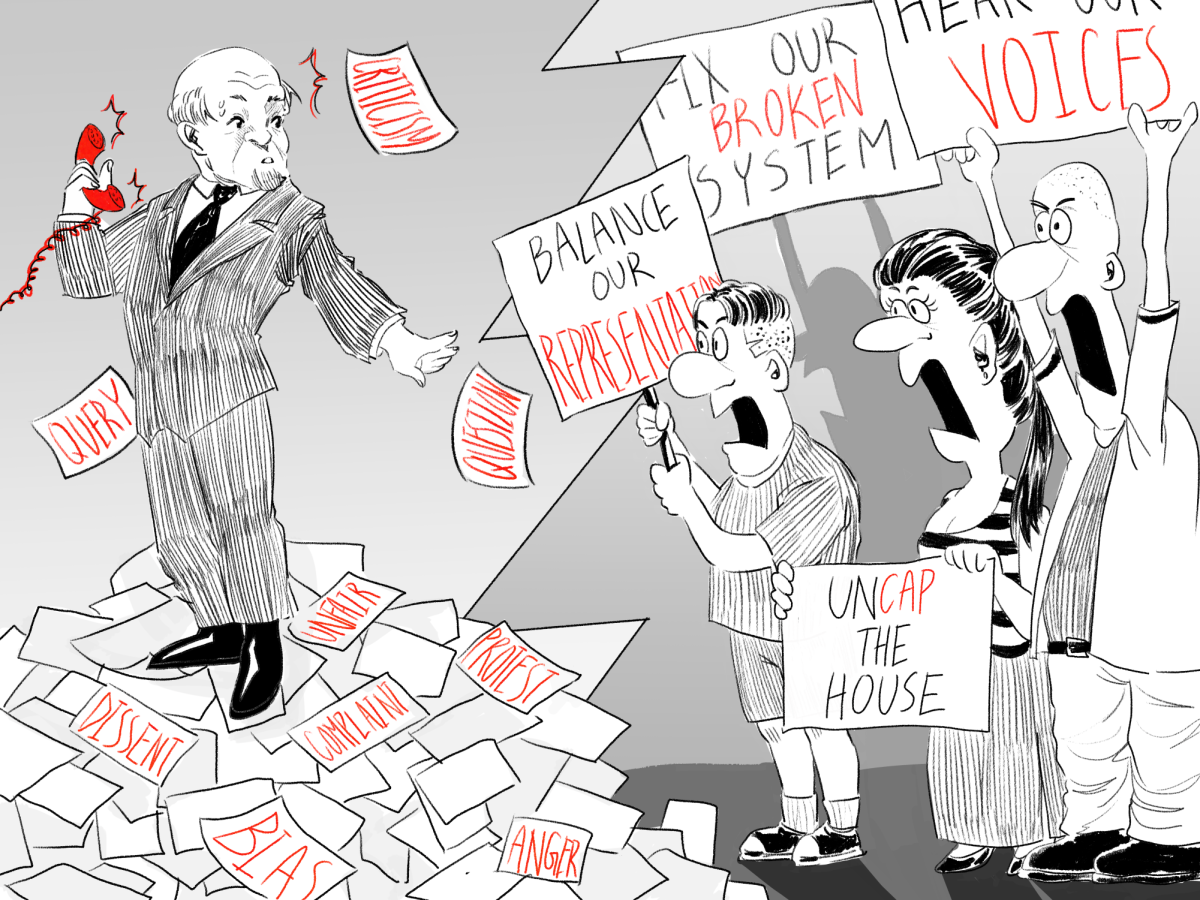When your representative decides how to vote on an upcoming bill in the House, how do they decide? Do they pay attention to calls and messages from their constituents to make up their mind? Or do they listen to diverse opinions and arguments from people across their district?
Of course not. Instead, the leaders whom we ourselves elected to be our voice in the highest legislature of our land simply follow the platform of their party, disregarding their district’s own unique values and opinions. However, that is not completely a representative’s fault, because doing so is simply not possible. As of 2020, an average of 761,000 people reside in every congressional district. That’s one representative for 761,000 people. How can one person possibly take into account the values and beliefs of that many?
Before Congress passed the Permanent Apportionment Act of 1929, which capped the size of the House to 435 seats, the number of representatives increased by small amounts every census, as dictated by a vote in Congress itself. In 1790, there were 105 representatives, each representing 37,400 people; in 1860, there were 241 for 130,000 people; and in 1930, 435 for 280,000. And now, a century later, there are still 435 representatives, but for triple the population. As a result, more and more voices are left unheard, and elected officials become disconnected from the people by whom they were elected.
Another result of a small House is the imbalance in representation of different states in Congress. Currently, each Montanan’s vote matters almost twice as much as a Delawarean’s, because Delaware, with its single representative, contains 991,000 people, while each of Montana’s districts encompasses 543,000.
The single most important reason why the size of our House must increase is that the fixed 435-seat legislature creates a detachment between representatives and the people they represent. They are no longer able to hear what their constituents have to say or take into consideration their beliefs on an issue before a vote. When you call the office of your own representative, an intern in their office picks up, and your message usually does not reach them; even worse, no one picks up your call, and you have no way of expressing your opinion to the person that is supposed to represent you in Congress.
There is a justifiable reason for this. There is simply no way for them to hear these messages when they are busy traveling and writing bills. The office of a representative receives dozens of calls a day. With an increase in the number of representatives, each one would represent fewer people and could listen to and consider more opinions. Furthermore, smaller districts mean more diverse candidates who represent the unique culture and ideas of that particular district, and therefore the entire House would be more representative of the widely varying values and beliefs that are found across the nation.
Increasing the number of representatives also results in unintended but vastly beneficial consequences. With more representatives in each district, the capability of partisan gerrymandering, or redrawing of districts to favor one party over another, is greatly diminished. This type of partisan redistricting, which is usually done by the party in power in the state government, leads to an overly skewed partisan lean that does not reflect the views of the people. By adding more seats to each state, the area of each individual district would be too small to effectively create districts in such a way that one party has an advantage over another. If the number of representatives increases, so does the fairness of our congressional maps.
Our country, with its 761,000 people per representative, is an outlier compared to other democracies across the globe. Most of America’s other international counterparts have much smaller districts: Canada has on average 118,000 people per member of Parliament and the United Kingdom just 103,000. Only India, with its population of 1.4 billion, has more people per representative.
435 is an arbitrary number. Why should it stay the same? Why should it not change accordingly after each census, based on the population of our country? Whether we divide the population by that of the smallest state to prevent overrepresentation or fix the number of representatives to the cube root of the national population, by increasing the number of seats in the House we can ensure that Congress truly does what it was designed to do: represent the people.
There are some who argue that expanding the House would not fix the flawed Congress we have today because they believe that adding more representatives would be detrimental to the ability of the House to operate efficiently. However, in the modern era where digital technology is so widespread, there is no reason why our national legislature would not use newer voting systems and more advanced methods of communication between the House floor, representatives, and their staff. Furthermore, those who disagree claim that more seats in the House would lead to more political extremists on both sides’ gaining power. Yet the typical American does not vote for third parties, and if there were more seats, they would not change the way they vote. In the 2022 House elections, only nine third-party candidates in the entire country received more than 5% of the votes in their district. Thus, expanding the House would not be able to fundamentally change the American political landscape in such a way that could enable radical extremists to win representation in Congress and create political instability.
The limit imposed on the number of House seats by Congress from a century ago is outdated and no longer serves a practical purpose in today’s time. In the 1920s, rural Republican representatives realized that a larger house size would hurt their party’s performance because of the significant population shift to urban areas, and thus refused to cooperate with the other side of the aisle to expand the House. Instead, being in the majority, they fixed the size of the House in order to ensure their own party’s survival.
Today, our country’s representatives no longer argue about how to reapportion the House in order to give their party an advantage. Americans are no longer moving to cities in huge numbers as they were during the 1920s. Not only does capping the size of the House unjustly give certain states more representation in Congress, but the large size of each district also prevents representatives from properly communicating with and listening to their constituents. So, in order for our country to remain fair and democratic, we must expand the House of Representatives.




![LALC Vice President of External Affairs Raeanne Li (11) explains the International Phonetic Alphabet to attendees. "We decided to have more fun topics this year instead of just talking about the same things every year so our older members can also [enjoy],” Raeanne said.](https://harkeraquila.com/wp-content/uploads/2025/10/DSC_4627-1200x795.jpg)


















![“[Building nerf blasters] became this outlet of creativity for me that hasn't been matched by anything else. The process [of] making a build complete to your desire is such a painstakingly difficult process, but I've had to learn from [the skills needed from] soldering to proper painting. There's so many different options for everything, if you think about it, it exists. The best part is [that] if it doesn't exist, you can build it yourself," Ishaan Parate said.](https://harkeraquila.com/wp-content/uploads/2022/08/DSC_8149-900x604.jpg)




![“When I came into high school, I was ready to be a follower. But DECA was a game changer for me. It helped me overcome my fear of public speaking, and it's played such a major role in who I've become today. To be able to successfully lead a chapter of 150 students, an officer team and be one of the upperclassmen I once really admired is something I'm [really] proud of,” Anvitha Tummala ('21) said.](https://harkeraquila.com/wp-content/uploads/2021/07/Screen-Shot-2021-07-25-at-9.50.05-AM-900x594.png)







![“I think getting up in the morning and having a sense of purpose [is exciting]. I think without a certain amount of drive, life is kind of obsolete and mundane, and I think having that every single day is what makes each day unique and kind of makes life exciting,” Neymika Jain (12) said.](https://harkeraquila.com/wp-content/uploads/2017/06/Screen-Shot-2017-06-03-at-4.54.16-PM.png)








![“My slogan is ‘slow feet, don’t eat, and I’m hungry.’ You need to run fast to get where you are–you aren't going to get those championships if you aren't fast,” Angel Cervantes (12) said. “I want to do well in school on my tests and in track and win championships for my team. I live by that, [and] I can do that anywhere: in the classroom or on the field.”](https://harkeraquila.com/wp-content/uploads/2018/06/DSC5146-900x601.jpg)
![“[Volleyball has] taught me how to fall correctly, and another thing it taught is that you don’t have to be the best at something to be good at it. If you just hit the ball in a smart way, then it still scores points and you’re good at it. You could be a background player and still make a much bigger impact on the team than you would think,” Anya Gert (’20) said.](https://harkeraquila.com/wp-content/uploads/2020/06/AnnaGert_JinTuan_HoHPhotoEdited-600x900.jpeg)

![“I'm not nearly there yet, but [my confidence has] definitely been getting better since I was pretty shy and timid coming into Harker my freshman year. I know that there's a lot of people that are really confident in what they do, and I really admire them. Everyone's so driven and that has really pushed me to kind of try to find my own place in high school and be more confident,” Alyssa Huang (’20) said.](https://harkeraquila.com/wp-content/uploads/2020/06/AlyssaHuang_EmilyChen_HoHPhoto-900x749.jpeg)





